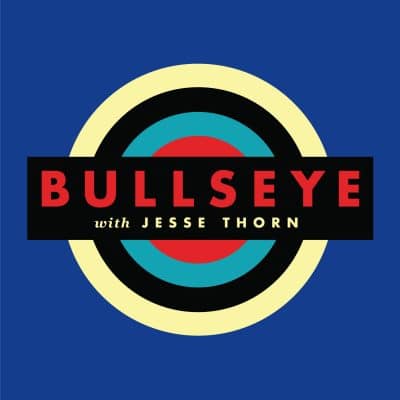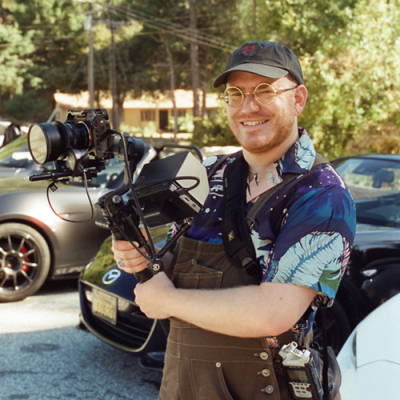Episode notes
Jon Ronson is a journalist, filmmaker and author of several best-selling books, including Them: Adventures with Extremists and The Men Who Stare at Goats. You may also know him from his contributions to This American Life.
His newest book is The Psychopath Test: A Journey Through the Madness Industry.
JESSE THORN: It’s The Sound of Young America, I’m Jesse Thorn. My guest on the program is the journalist Jon Ronson. He’s made a career of tracking down wing-nuts and extremists and people on the fringes of all sorts of societies. His latest book is called The Psychopath Test: A Journey Through the Madness Industry.
It starts with a puzzle book, and travels through a long investigation of psychopathy and psychiatry. Jon Ronson, welcome to The Sound of Young America.
JON RONSON: It’s a pleasure to be here.
Click here for a full transcript of this interview, or jump to the podcast audio.
JESSE THORN: When I was in high school, I interned in the Mayor’s office of San Francisco. I worked in the Mayor’s Office of Neighborhood Services, if you pick up the phone and call the mayor’s office from the phone book, that’s who you get; and if you send a letter that just says, to the mayor, San Francisco, California, that’s who you get. It was my job to respond to some of the less coherent letters that we received. There was a woman who wanted us to intervene with the CIA who were sending pigeons to her house.
JON RONSON: I get so many “I’m being tracked by the CIA” letters. So many. In England it’s MI5. MI5 is in a transit van for part of my drive monitoring me, can you investigate? I want to say to them, they don’t have the staff!
JESSE THORN: They lack the sheer man power.
JON RONSON: We used to get a monthly newsletter from a gentleman named James Bond Zero of The Hardware Secret Service. We could never figure out what it was supposed to be. It would come to us – – this was in the late 1990s, so it would come to us looking like it had come out of Broderbund print shop, and it was laid out like a company newsletter. Often there would be articles that would start with words and then just devolve into letters.
JON RONSON: The thing that’s so interesting about this for me, I began to realize over time, is that when peoples brains go wrong they go wrong in eerily similar ways. There’s so many people who share the same delusion that the CIA are after them or that MI5 is after them. It’s weird that people who never meet each other share this delusion about themselves.
JESSE THORN: The story of your book starts with you hearing about something not too far from this and deciding as the chronicler of the bizarre and the extreme that you are to pull on the string.
JON RONSON: I was contacted by a neurologist who said – – I get a lot of e-mails saying, will you investigate this? I tend not to, but there was something about this particular e-mail, she said she was a neurologist and she got sent a mysterious package through the mail, and it was an incredibly expensive puzzle book, but with no indication as to what the puzzle was, how to solve the puzzle, who had written it, why she had been chosen. What she discovered was that academics all over the world had been sent this book, and they all met on the internet to work out why they had been chosen; had they all been to the same conference together or something? It was is if the solution was just out of reach, but they couldn’t do it. Eventually one of them said, maybe we’re too brilliant to solve this evidently brilliant puzzle. Lets bring in someone more brutish, like a journalist, and so they called me.
JESSE THORN: As a journalist, you got this piece of information, this incredibly baroquely complicated puzzle book that involves some pages with information, some pages without, some pages cut out; it’s printed in a beautiful and expensive manner, and because you’re a journalist, you had a specific response to it; which was, you wanted to take this piece of information you had and build it into a narrative.
JON RONSON: What I discovered looking through Swedish libraries – – I should explain that these books – – all we knew was that the book had come from Sweden, from Gothenberg. What I discovered was that there was a man listed in a Swedish library as the translator of this book, Being or Nothingness; a man called Petter Nordlund. I had a name, so I flew to Gothenberg to meet this guy.
JESSE THORN: You’re in the unique position to be able to buy an airplane ticket on the basis of that amount of information.
JON RONSON: I’m lucky, this is just because they turned one of my books into a movie, The Men who Stare at Goats, which gave me the freedom to follow my nose in these crazy adventures. Thank god, it gave me a bit of money.
JESSE THORN: So you flew to Sweden and met this guy, you did this sort of Mike Douglas “60 Minutes ma”neuver on him and just showed up at his door.
JON RONSON: Yeah, which obviously made me feel anxious, but then again, everything makes me feel quite anxious.
JESSE THORN: I get the impression that what you found wasn’t what you as a journalist and storyteller hoped you might find, even though you did find the source of the books.
JON RONSON: I was under the impression, like all the recipients of the book were, that some brilliant rational thing was at work. What I discovered almost immediately upon landing in Gothenberg was that the whole thing was nuts. It was basically a guy who was likably nuts, but nuts, and the reason that nobody could solve the puzzle was because it was nuts.
I, after a moment’s disappointment, realized it was unbelievable. It’s great. What happened here is that neurologists all around the world have become completely intrigued – – they were just getting on with their boring rational lives like a still pond, and then this happened, this kind of nuttiness happened, which was like a rock thrown in the pond. Loads happened because of this one man’s nuttiness, to the extent that I flew to Gothenberg to solve this mystery, and that gave me this epiphany, which was, is that how society works? Is madness a more powerful engine in society than rationality? Then I started remembering this conspiracy theory by eminent psychologists, that there’s this type of madness that really makes society go round, and it’s psychopathy. Psychopath’s rule the world, because their brain anomaly propels them to be ruthless and successful and that it’s the brain anomaly that filters down and affects all of us, and so I started thinking if I could write a book about the possibility that madness rules the world.
JESSE THORN: And you decided to pursue this by going first to that most natural of sources, the British Church of Scientology.
JON RONSON: Haha, yeah. I felt if I was going to write a book about the possibility that madness rules the world, I needed to look at the possibility that psychiatry couldn’t be trusted, and that’s how I ended up meeting the Scientologists.
JESSE THORN: The Scientologists run this entire outfit called The Citizens Commission on Human Rights, which is – – they have this museum here in Los Angeles called Psychiatry: An Industry of Death, if I remember correctly.
JON RONSON: You remember correctly.
JESSE THORN: They introduce you to a guy who they consider to be the perfect example of psychiatry gone bad. Some people may have heard your piece on this on This American Life, but tell me a little bit about what it was like to meet this guy Tony in the criminal loony bin.
JON RONSON: Yeah, in a place called Broadmoor, which is a very notorious – – used to be called an asylum for the criminally insane, and now it’s called a high security mental hospital.
JESSE THORN: This is a place where Joker, Batman’s enemy, lives?
JON RONSON: Oh, really?
JESSE THORN: No, not in a narrative, but this is that kind of place?
JON RONSON: Yes, they send the serial killers and the sex murderers and Britain’s most famous – – the Stockwell Strangler. The Moors murderers, who are really Britain’s most appalling killers of the last hundred years ended up there. Really scary place. They said that there was this guy called Tony, and all he had done was beaten somebody up, which by Broadmoor terms was very light, when he was 17. He was awaiting trial, and decided, on the advice of his fellow inmates in a prison, to fake madness. They said, fake madness, you’re looking at five to seven years in prison, but if you fake madness you’ll get sent to some cushy hospital, nurses will bring you pizza, you’ll have a PlayStation, it’ll be great. So he fakes madness way too well and ended up at Broadmoor, and took one look at the place and said, I’m not mad. Broadmoor is a soul destroying place. The minute you go there, it’s just the world’s most depressing place.
JESSE THORN: You found this guy to be quite charming and for the most part quite convincing.
JON RONSON: It was extraordinary. Brian, the Scientologist, took me to the Wellness Center inside Broadmoor, which was behind a zillion fences, which is where people were meeting their loved ones. All the patients came in wearing sweatpants and they were overweight and sad-eyed and docile. Brian actually whispered to me, “They’re medicated.” Which made me realize how strongly the Scientologists felt about things like medication. To Brian it was a scandal that these people were medicated; of course, to me, I was thinking it was probably a good idea.
JESSE THORN: A lot of them were real murder-y before they were medicated.
JON RONSON: Right. And then Tony turned up and looked nothing like the others. The others were all fat or looked incredibly eccentric, like they thought they were Jesus. Tony showed up in a pin striped suit looking like somebody from the apprentice, and walked towards me with his arm outstretched. This is the kind of outfit of a man who wants to prove to everybody that he was really sane, and of course, thinking does this prove that he is sane, or does it prove that he’s entirely nuts?
JESSE THORN: You learned when you talked to the people who were treating this guy, that as you incredulously stated to them, they agreed that he had faked mental illness to get into the hospital, but what they told you was that that was typical behavior for a psychopath.
JON RONSON: This was the thing, they accepted after a little while, it took them a couple years to convince them that he had really faked madness, and they eventually accepted that, but once he was there they said, well, you’re a psychopath, and in fact faking madness to get out of a prison sentence is exactly the kind of conning and manipulative acts of a psychopath, and meeting a pin stripe suit to meet a journalist is again a typically grandiose and superficially charming act of a psychopath. Everything that seemed most sane about Tony was actually evidence in this new theory that he was a psychopath.
JESSE THORN: Welcome back to The Sound of Young America, I’m Jesse Thorn. My guest is Jon Ronson. His new book about people with no capacity for empathy is called The Psychopath Test: A Journey Through the Madness Industry.
This lack of empathy is something that can not be – – is very difficult to directly observe. There’s ways that you can get evidence of it by hooking people up to an FMRI and showing them something horrifying and seeing if their brain lights up in a certain way, but it’s very difficult for a psychiatrist to just say to someone, “Do you lack empathy completely?” And have them say “Yes, of course I do,” because, among other things, they might be cunning enough to know that that would label them a psychopath.
JON RONSON: Yes.
JESSE THORN: So there’s this checklist, and this checklist is a way of inferring if someone is a psychopath.
JON RONSON: Yes, through the nuances of their language and through cunning interviewing style as well. This is where psychiatrists and psychologists meet journalists. You ask the right question in a slightly faux naive way to get them to reveal themselves, to get them to reveal themselves, to reveal their lack of empathy when they don’t realize that’s what you’re trying to do.
It sounds kind of amateur sleuth territory. This is the problem that people who work with psychopaths have. If you’re in the grips of an OCD attack or bi-polar attack or something like that, it’s obvious. You don’t need to be Hercule Poirot to spot that, but you do need to be Hercule Poirot to spot a psychopath, because they bury it. They seem utterly normal when you meet them.
JESSE THORN: You went to a seminar hosted by the guy who created this checklist, and you’ve learned along with a variety of psychologists and law enforcement people about identifying people who were like this. How did that change you? Specifically, in addition to just the sheer pleasure of identifying psychopaths around you, how did it change the way you looked at your job, which is in part about interviewing people and leading them into inferences that you can make and so on and so forth?
JON RONSON: It was a shock. The first thing that happened – – I went into this course as a skeptic, particularly because I’d been spending quite a lot of time with Scientologists, but by the end of the course I was not only a convert, but a passionate and fundamentalist convert. It’s very convincing going on the Hare course, mainly because an extraordinary, mind-blowing facet of humans is that when our brains go wrong, they really do go wrong in uncannily similar ways. So psychopaths do, if you talk to them in the right way, reveal themselves by using turns of phrase that are identical to each other. That’s very real.
For instance, this isn’t in the book, but subsequent to writing the book I interviewed this guy, and I said to him, what kind of kid were you? He said, oh, I was in a gang, I led a gang and we used to beat up other kids. My psychopath checklist brain lit up and I said, oh really, what was that like? Did you enjoy beating people up? He goes yeah, it gave me a feeling of control. Control is a big word. I said, looking back on it now, do you still feel good. He said yeah, I feel good to think about jumping out from behind a tree and beating a guy. That was the kind of thing I was learning on the course, that these people would use very similarly turns of phrase when they were off guard. So it blew me away and I became a total fundamentalist psychopath spotter and I started spotting psychopaths everywhere to the extent that I kind of went a little psychopathic. I started dehumanizing people, wedging them into psychopath boxes, and I think this is very common, by the way. Hare would say it’s common, and Hare would say it worries him that people with real power, people with power to get people locked up beyond their prison terms go drunk with power in the same way that I did, because the checklist is a very seductive things.
I realized that that’s what we journalists do all the time. We like to entertain people with the madness of our interviewees in a slightly morally corrupt manner. The second half of my book looks at that.
JESSE THORN: There’s this really scary thing about the diagnosis of psychopathy, which is that it’s a condition that is permanent and unchangeable.
JON RONSON: The consensus is that that’s it. You can’t get better like you can with anxiety disorders and bi-polar disorder. Well, you know, bi-polar disorder is another one that’s considered basically life long. But certainly disorders like OCD and schizophrenia you can recover from, but psychopathy you can’t, it’s what you are and you can never change. If you score, it’s kind of arbitrary, if you score 29 or 30 out of a possible 40 on the psychopath checklist, that’s it. You’re a psychopath for life. And if you faked madness to get out of a prison sentence and you ended up in Broadmoor, you’re screwed. You’re a psychopath forever. The consensus is that the only time that you’re no longer considered a danger is when you get too old and too tired to re-offend.
JESSE THORN: It’s a very scary thing because, in part, this is a diagnosis that suggests – – for one thing, it’s scary because we are forced to dehumanize someone for their ability to dehumanize others. It’s scary because it’s lifelong and we can’t change it, it’s scary because its symptoms are exactly the symptoms of someone who doesn’t have it and wants to convince us that they don’t have it. It’s scary for a lot of reasons, but one of them is that because this is, at least for now, untreatable, it leads to a punishment that we don’t really have the kind of legal and moral and philosophical means to deal with.
JON RONSON: You’re absolutely right. There are these places springing up all over America at the moment, these homes for pedophiles, I suppose is what they are, where once a pedophile has done their time in prison, they think they’re getting out, but in fact they’re met at the door by somebody who says no, we’re going to take you to this place. There’s one in California called Coalinga, and they’re there for the rest of their lives, that’s it, because they’ve scored high, quite often in absentia, on the psychopath checklist.
Robert Hare said to me that the people who administer these tests, who send these pedophiles to these places where they’ll never get out of, he says when I’m trying to teach them how to administer the checklist they’re picking their nails, and they’re doodling, and these are the people who are deciding who will never ever be released. It’s very Orwellian and it’s really happening.
JESSE THORN: You dive, towards the end of the book, into this desire in the past 35 years or so to transform psychiatry from an art-like pseudoscience into a proper science, and this psychotic checklist is just one part of that effort, in that it is an attempt to create in empirical method rather than a subjective method to diagnose this disease, and this is something that’s going on not just in psychopathy but in many disorders, everywhere across the spectrum of mental health issues that people might have. Part of that is that in the late 1970s early 1980s, the diagnostic manual, the DSM, was expanded dramatically to include many more conditions than it had before, in part because of an effort to more scientific these diagnoses. They said, well, we’re going to put them in a book, and we’re going to put down a list of characteristics that people have.
JON RONSON: Yeah, and the way to describe it sounds really reasonable because – – I kind of get in trouble for saying this because Freudian is flawed, right? It’s all about sleuthing around the subconscious and a lot of stuff like repressed memory syndrome has been proven to be untrue. Freudian psychotherapy is not great, and I understand why they wanted to try and do something more scientific, it’s reasonable. But the problem is that people fall in love with the checklists, and the worst thing that’s going on is childhood bi-polar disorder where three year old kids are being labeled and medicated as bi-polar because they have temper tantrums, and that looks like an item on the bi-polar checklist. It’s open to terrible abuse.
JESSE THORN: I think it’s fair to say that both you and I are members of the media; I may be a bit more of a pseudo-journalist than you are, but we’re both in this world. As I read that part of the book, what I was thinking about in addition to this epidemic, or potential epidemic of over diagnosis was the relationship between this discipline of psychiatry and my own discipline of journalism, which is to say that there are elements of journalism that are about narrative, exclusively, like something really frivolous on This American Life might be an example of that; something that is about an entertaining real life story. That is one extreme, and most of them live in this liminal area that is between telling us stories because we like to hear stories, and explaining to us something important, and very few of them are empirical studies.
JON RONSON: Absolutely, so what does it come down to? How do you regulate yourself? The only way of doing it is to try in an expanding and more stressful market to be a moral person. I love the fact that, for instance, the This American Life people are very humanist. They always want to see the best in somebody, they’re always looking for the moment of empathy that you can connect to, which is obviously a great impulse. But on the other end of the scale what you’re getting more and more is this kind of disgusting proclivity to tell stories that basically mock crazy people, and it’s happening in mainstream television and magazines in America and Britain.
The biggest show in Britain at the moment, by far, is called My Big Fat Gypsy Wedding, where every week they make fun of Gypsies. I think you guys are going to get it quite soon in America. It’s basically, let’s mock Gypsies for being vulgar. It’s getting six, seven, eight million viewers in Britain every week. It’s a corrosion of morality. I’ve noticed it happening with things like The Apprentice. Series One of the Apprentice, certainly the British Apprentice, was a very incisive look at capitalism. Series five of The Apprentice is just fragile narcissists falling apart in suits. It just shows how terrible factual programming is getting.
JESSE THORN: Jon, I really appreciate you taking the time to be on The Sound of Young America.
JON RONSON: I enjoyed it a lot, thank you.
JESSE THORN: Jon Ronson’s book, which is really a blast despite moments of very dark tone in that conversation, is called The Psychopath Test: A Journey Through the Madness Industry.
Our transcripts are provided by Sean Sampson. If you’re interested in contacting him for transcription work, email him here.
In this episode...
Guests
- Jon Ronson
About the show
Bullseye is a celebration of the best of arts and culture in public radio form. Host Jesse Thorn sifts the wheat from the chaff to bring you in-depth interviews with the most revered and revolutionary minds in our culture.
Bullseye has been featured in Time, The New York Times, GQ and McSweeney’s, which called it “the kind of show people listen to in a more perfect world.” Since April 2013, the show has been distributed by NPR.
If you would like to pitch a guest for Bullseye, please CLICK HERE. You can also follow Bullseye on Twitter, YouTube, and Facebook. For more about Bullseye and to see a list of stations that carry it, please click here.
Get in touch with the show
People
How to listen
Stream or download episodes directly from our website, or listen via your favorite podcatcher!






